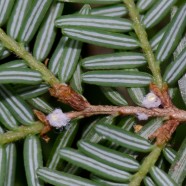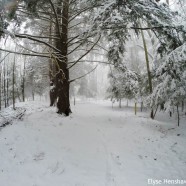Survey Work Continues
Call us crazy, but we have done it again: bundled ourselves up and trudged around in knee deep snow to survey for the deadly Hemlock Woolly Adelgid. This time, our JCC/CWC/RTPI survey team traveled down to Warren County to visit the Hatch Run Conservation Demonstration Area for the second year in a row. This site is loaded with Eastern Hemlock trees that make up a beautiful and valuable riparian zone between the streams and upland forests. We are happy to report that we didn’t find the pest we were after (which is a good thing!) and being in that particular site made us really think....
Read MoreSuccessful 1st Survey
I am very happy to report that our team comprised of RTPI staff and JCC faculty and students did not find Hemlock Woolly Adelgid (HWA) on any of the 200+ trees we surveyed at South Valley State Forest! Although the temperatures were chilly, we had a beautiful sunny day to be out in the hemlock stands trudging our way through the knee deep snow. Prior to our survey we ran our student surveyors through background information about this deadly invasive bug threatening the area’s hemlock trees. We went over look-alikes and our field protocol, then headed out the door to our destination....
Read MoreCollaborative Forest Pest Project Update
They always say, pictures are worth 1,000 words. And in most cases I would agree with that. There is always an interesting story behind each photograph we take or view. Photographs can capture a joyous or disheartening scene, appeal to our emotions or bring our attention to someone or something in need. This past weekend, as a part of our joint Forest Pest Outreach Project with Cornell Cooperative Extension of Chautauqua County, Betsy Burgeson, my husband Tyler and I all got out to North Harmony State Forest to erect signs on Eastern Hemlock trees along the main snowmobile trail and cross...
Read MoreHWA Here to Stay?
It’s official friends, HWA has been found in Chautauqua County. Over the holidays, Hemlock Woolly Adelgid (HWA) was encountered on a number of Eastern Hemlock trees (Tsuga canadensis) near Fredonia. These trees exhibited the signs and symptoms of the invasive insect’s presence, having twigs covered in white woolly masses and dying needles, discolored due to loss of nutrients. Due to its small size and discrete nature, HWA can easily go undetected until it is too late, and death of the attacked hemlock is inevitable. However, it CAN be stopped and we CAN help the hemlocks...
Read MoreSnowy Scene
With the first official day of winter only about 10 days away, the landscape in Western New York is certainly looking the part thanks to all the recent snow we have received (and are still getting!) from a big Nor’easter that has moved its way up the coast. I took a walk this morning on some of our trails here at RTPI and captured one of my favorite scenes: eastern hemlocks (Tsuga canadensis) dripping with snow. While I was photographing the trees, the winds picked up causing the snow to come swirling down from the branches and needles, making the trail look a bit like a snow-globe....
Read More








